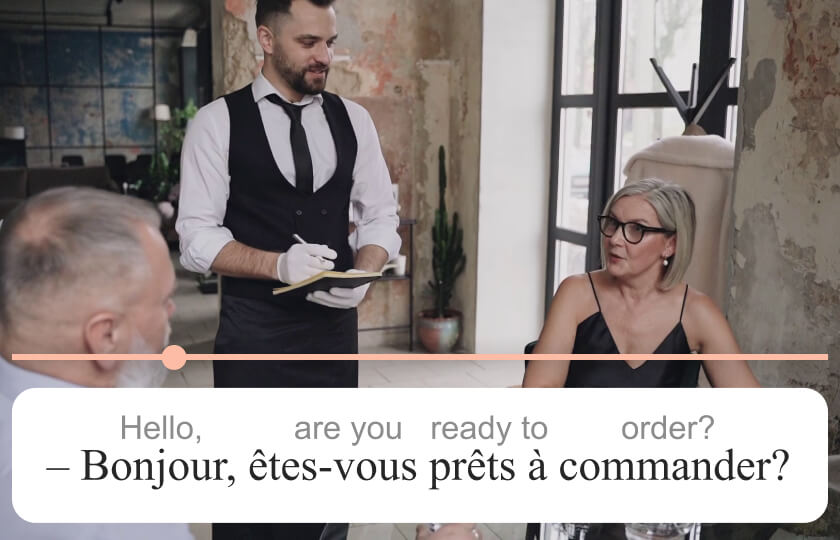Struggling with French grammar? You’re not alone. Here are the top 5 mistakes new learners make and how to fix them:
- Using wrong word gender
- Putting adjectives in the wrong place
- Using incorrect verb tenses
- Mixing up “c’est” and “il/elle est”
- Confusing “connaître” and “savoir”
Quick cheat sheet:
| Mistake | How to fix |
|---|---|
| Word gender | Learn nouns with articles (le/la) |
| Adjective placement | Most come after nouns, except BAGS (Beauty, Age, Goodness, Size) |
| Verb tenses | Passé composé for completed actions, imparfait for ongoing past |
| C’est vs Il/Elle est | C’est for general statements, Il/Elle est for specific descriptions |
| Connaître vs Savoir | Connaître for familiarity, Savoir for facts and skills |
Related video
1. Using Wrong Word Gender
Getting word gender right in French is a big deal. Gender affects articles, adjectives, and pronouns. It also:
- Shapes the whole sentence structure
- Can change what words mean
- Shows how well you know French
The Basics of French Gender
French nouns are either masculine or feminine, this is just how the language works. It doesn’t always make logical sense, for example:
- le livre (the book) – masculine
- la table (the table) – feminine
Spotting Gender Patterns
Some word endings can give you clues about a noun’s gender:
| Usually Masculine | Usually Feminine |
|---|---|
| -age (le voyage) | -tion (la nation) |
| -isme (le tourisme) | -té (la beauté) |
| -ment (le moment) | -ance (la chance) |
| -eau (le bateau) | -ette (la bicyclette) |
But watch out – there are always exceptions!
When Gender Changes Meaning
Sometimes, changing the gender completely changes the word:
- le voile (the veil) vs. la voile (the sail)
- le livre (the book) vs. la livre (the pound)
Tips to Master Gender
1. Learn nouns with their articles. Don’t just memorize “chat” for cat – learn “le chat”.
2. Practice gender agreement. Make sure your adjectives and articles match the noun’s gender.
3. Surround yourself with French. Watch French videos, read French books, listen to French podcasts.
Don’t stress if you make mistakes – even native French speakers get it wrong sometimes.
2. Putting Adjectives in the Wrong Place
French adjective placement can trip up English speakers. Why? In French, most adjectives come AFTER the noun they describe. It’s the opposite of English.
Examples:
- une voiture rouge (a red car)
- un repas délicieux (a delicious meal)
- un livre intéressant (an interesting book)
But there’s a twist. Some adjectives come BEFORE the noun. Remember them with BAGS:
| Type | Example |
|---|---|
| Beauty | – un beau tableau (a beautiful painting) – une belle armoire (a beautiful wardrobe) |
| Age | – un vieux château (an old castle) – une jeune étudiante (a young student) |
| Goodness | – un bon croissant (a good croissant) – une mauvaise nouvelle (a bad piece of news) |
| Size | – un grand magasin (a large store) – une petite table (a small table) |
Here’s where it gets tricky: some adjectives change meaning based on position. For example:
- ancien / ancienne:
- mon ancienne maison (my former house)
- la maison ancienne (the ancient house)
- cher / chère:
- cher Mark (dear Mark)
- un canapé cher (an expensive sofa)
Want to improve? Try these:
- Read French texts and note adjective usage.
- Create sentences with different adjectives.
- Use French grammar apps for practice.
- Listen to French podcasts or watch French movies.
3. Using the Wrong Verb Tense
French verb tenses can be tricky. They’re more complex than English and used differently. Let’s look at some common mistakes and how to fix them.
The Infinitive vs. Conjugated Form
A big mistake is mixing up infinitives and conjugated forms. Here’s a quick guide:
| When to Use | Example |
|---|---|
| Infinitive: after connector verbs | Je veux manger une pomme I want to eat an apple |
| Conjugated: after subject | Je mange une pomme I eat an apple |
After verbs like vouloir (to want), aimer (to like), and pouvoir (to be able to), use the infinitive.
Passé Composé vs. Imparfait
Choosing between Passé Composé and Imparfait for past actions can be confusing. Here’s the difference:
| When to Use | Example |
|---|---|
| Passé Composé: completed actions | J’ai mangé une pomme hier I ate an apple yesterday |
| Imparfait: Ongoing or habitual past actions | Quand j’étais jeune, je mangeais souvent des pommes When I was young, I often ate apples |
How to Get Better
Want to nail your French verb tenses? Try these:
- Conjugate verbs every day. Focus on different tenses.
- Look for context clues. Words like hier (yesterday) often mean Passé Composé, while chaque jour (every day) hints at Imparfait.
- Read French texts. Seeing correct usage in context helps it stick.
4. When to Use C’est vs. Il/Elle Est
Mixing up “c’est” and “il/elle est” is common at the beginning. Both mean “it is” or “he/she is” in English, but they’re used differently in French. Let’s break it down:
C’est: General Statements and Identification
Use “c’est” for:
- Pointing things out
- Making general statements
- Expressing opinions about places, meals, or people
Examples:
- “C’est un chien.” (It’s a dog.)
- “C’est Michel, le boulanger.” (This is Michel, the baker.)
- “C’est un endroit magnifique!” (It’s a beautiful place!)
Il/Elle Est: Specific Descriptions
Use “il/elle est” for:
- Describing specific subjects or objects
- Talking about professions (without an article)
- Telling time
Examples:
- “Il est charmant.” (He is charming.)
- “Elle est chanteuse.” (She is a singer.)
- “Il est 15 heures.” (It is 15:00.)
Here’s a quick reference table:
| C’est | Il/Elle Est |
|---|---|
| Modified nouns | Unmodified professions |
| Proper nouns | Specific descriptions |
| General concepts | Telling time |
| Expressing opinions | Referring to a previously mentioned noun |
Think of “c’est” for broader statements and “il/elle est” for specific descriptions.
Want to improve? Try these:
- Make flashcards with common “c’est” and “il/elle est” phrases
- Practice using both phrases daily
- Pay attention to how they’re used in French videos and texts
5. Connaître or Savoir: Which One to Use
French learners often get stuck when picking between “connaître” and “savoir”. Both mean “to know” in English, but they’re not interchangeable in French. Let’s break it down.
Savoir: For Facts and Skills
Use “savoir” when you’re talking about:
- Knowing how to do stuff
- Knowing about situations
- Expressing learned info
For example:
- “Je sais nager.” (I know how to swim.)
- “Je sais où tu habites.” (I know where you live.)
Here’s a twist: in the past tense, “savoir” means “found out”:
- “J’ai su qu’il a menti.” (I found out that he lied.)
Connaître: For Familiarity
“Connaître” is all about being familiar with something. Use it for:
- Knowing a person
- Being familiar with a place or thing
- Recognizing something
Examples:
- “Je connais Michel.” (I know Michel.)
- “Je connais Paris.” (I’m familiar with Paris.)
In the past tense, “connaître” means “met for the first time”:
- “J’ai connu Michel à Paris.” (I met Michel in Paris.)
Quick Comparison
| Savoir | Connaître |
|---|---|
| Facts and info | People, places, things |
| Skills | Familiarity |
| Can follow with clause or infinitive | Uses direct object |
How to Remember
Think of it this way: if you can swap “know” with “be familiar with” in English, go for “connaître” in French. For facts or skills, stick with “savoir”.
Marie Dubois from Alliance Française puts it nicely:
“Think of ‘savoir’ as knowing in your mind, and ‘connaître’ as knowing through experience. This mental picture helps in most situations.”
Conclusion
Learning French grammar isn’t easy. But it’s not impossible either. By focusing on common mistakes, you can fast-track your progress.
Want to boost your French grammar skills? Try these:
1. Dive into French: Listen to podcasts, watch movies with subtitles, read newspapers. It helps you absorb grammar naturally.
2. Practice daily: Even 15 minutes counts. Consistency is key.
3. Get feedback: Join a French class or use online coaching. Feedback speeds up learning.
4. Use apps: Tools like Wlingua and Kwiziq can help you practice your grammar.

